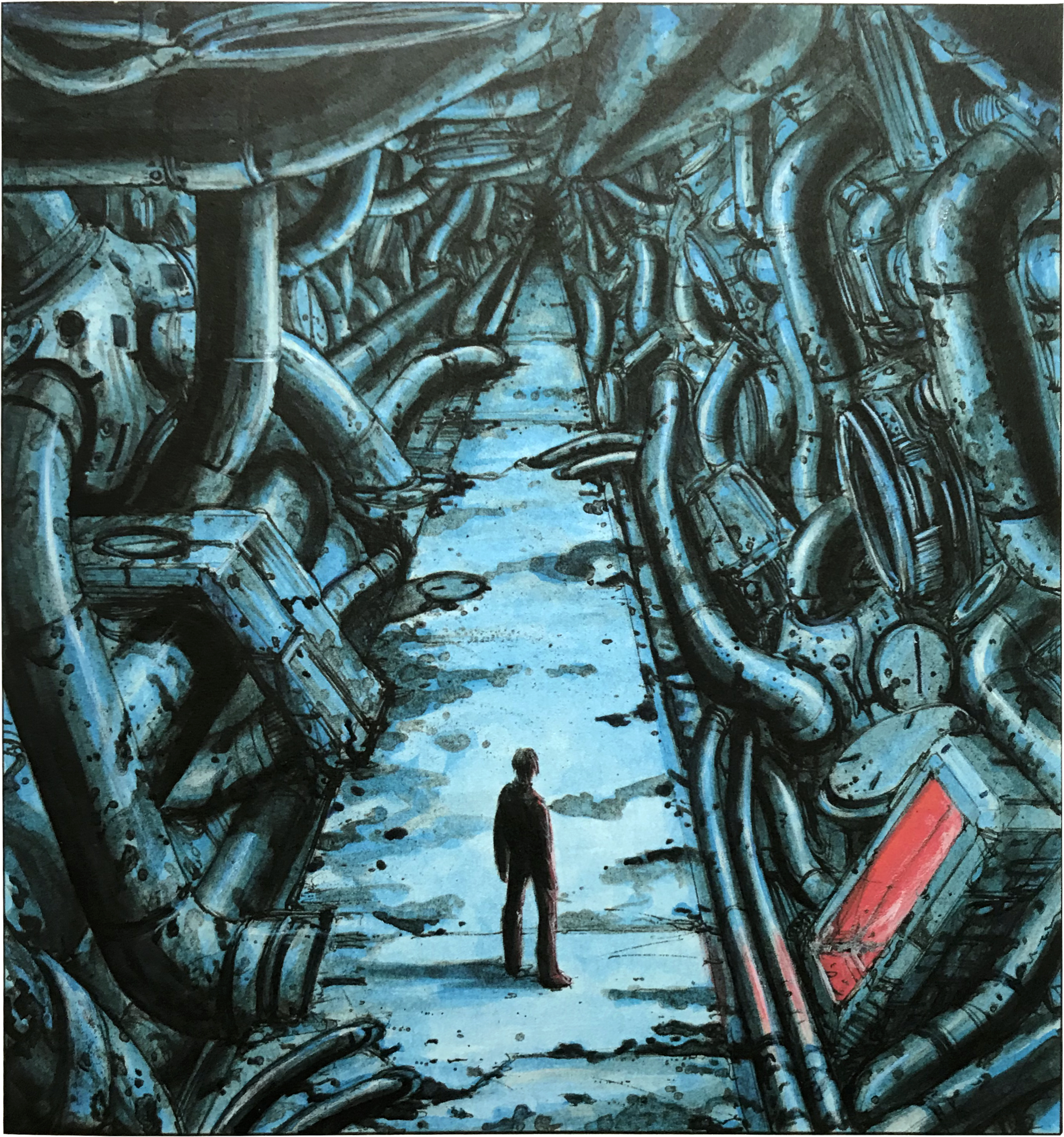
Earlier this year I pulled this book from the shelf of a friend and asked to borrow it:
working through the cleverest if most frustrating book I have read this year pic.twitter.com/wJ3WQer2Qa
— Toby (@tobyshorin) July 31, 2017
Architectures in Time turns out to be light on architecture and heavy on theory. The ideas I found inside merited more than a brain dump of notes, so what follows is not quite an essay but is somewhat more than a review.
Sanford Kwinter is the kind of writer who relies on what I’ve recently started to call “aesthetic logic.” Traditions like analytic philosophy rely on formal logic and are generally committed to truth and knowledge. Aesthetic logic, on the other hand, inherits the stylistic tendencies of art writing and postmodern language.
Aesthetic logic is suggestive or descriptive, rather than declarative. It presents a subjective perspective rather than trying to hammer out an objective one. Like art writing, it often gives objects undue agency; like postmodern language, it is often intentionally vague and even offers competing claims in the same sentence. One of the most important rules of aesthetic logic is that it doesn’t have to be right; it just has to make an interesting connection between two things.
And this is why there is still a logic to it. Kwinter’s sort of writing makes connections between architecture, literature, cinema, and philosophy that don’t rationally have to do with one another, but aesthetically make sense together. (A postmodern writer would say something like “they oscillate.”) I found Kwinter’s writing style to be particularly evocative of the concept he spends most time thinking about: multiplicity.
–
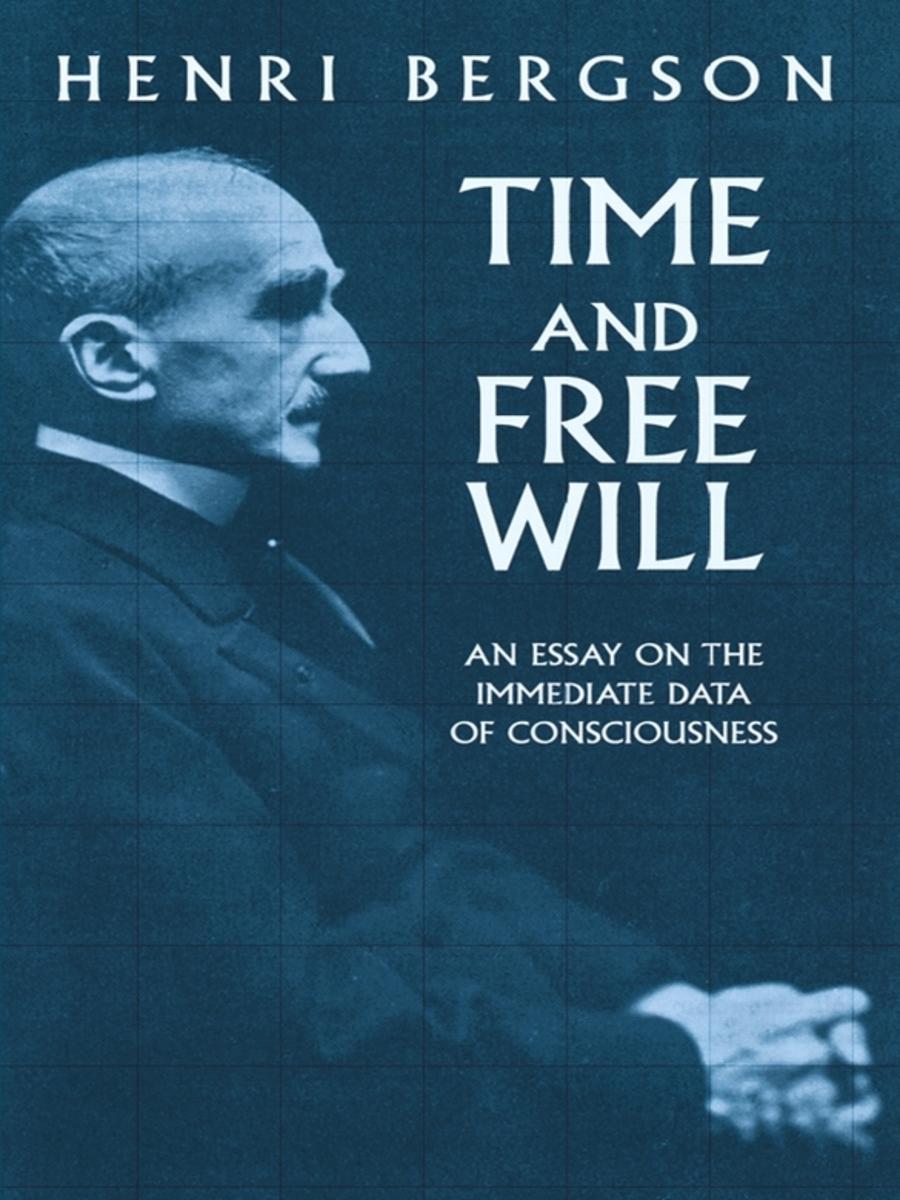
Kwinter picked up this idea from 20th century philosopher Henri Bergson. What then is a multiplicity? Sound it out in your mouth. Multiplicity. It could be a noun or an adjective. It sounds like it means “several things.” And that is indeed what it means, but according to Bergson there are two types of several: quantitative and qualitative.
Quantitatively speaking, “several” is just a bunch of homogeneous things, such as dollar bills. There is no qualitative difference between one one-dollar bill and the next, but they can be counted up together. Also, they take up space when you stack them.

A quantitative multiplicity is like a stack of dollar bills. Its parts are discrete and thus spatial, it is measured in number, and can be represented with a symbol like $100.
This book is spent discussing the other sort: qualitative multiplicities. What does it mean to be qualitatively “several?”
A while back, I was brutally, gloriously subtweeted. I went through a whole series of feelings: shame, outrage, vindictiveness, remorse, and acceptance. Where did one emotion stop and the other start? Were my feelings directed more towards myself or towards my ostensible aggressor? It would be impossible to individuate these qualitative emotional states, because in a way they rely on each other. But they certainly felt different.
A qualitative multiplicity is composed of several heterogeneous states which permeate and flow into one another. Like experiencing emotions these states can’t strictly be counted or numbered because they aren’t totally distinguishable. Even using the word “several” to describe them is somewhat misleading. Unlike dollar bills, which can be stacked, or Bergson’s pet example of sheep, which can be flocked, qualities do not exist in space and they are not individually distinct: “Qualities cannot be divided without changing in nature; quantities change only in degree” (emphasis Kwinter’s).

If changes in a multiplicity cannot be expressed spatially, then how? This gives us Bergson’s greatest contribution to philosophy. The measure of qualitative change is time, because “it is only qualitative changes of state, differentiations, that can account for the appearance of the new.”
Whereas the smallest unit of degree is a numerical fraction of whatever we are counting, the smallest unit of time would be the smallest instance of differentiation. This is the titular concept of “event.” An event, or a “singularity” as Kwinter also calls it, kicks off a cascade of qualitative change within and across a system.
The invention of the steam engine, for example, combined with flows of capital to give rise to the cotton gin, which allowed for the reorganization of town structures and the creation of urban centers, ultimately creating vast economic migratory systems. Like the steam engine, a small perturbation in a flow of unfolding differentiations (time) can combine with other flows to induce further difference and many orders of effects at other levels of complexity.
Intermission: Some Curiosities
Now that “qualitative multiplicity” doesn’t sound as daunting, we can spend a minute exploring what a rich concept it really is. Already it has made itself useful by providing me with cute cultural potshots.
I was reading Kwinter’s book in a Starbucks when I had a disconcerting realization. Although I had never been to this particular location, the music, furniture, and interior design were no different than a Starbucks in a different country I had sat in 10 years ago, and it wouldn’t be in another 10 from now. Starbucks locations suffer from absolute homogeneity. Stuck in StarbucksTime™, each branch lacks any differentiation from the next. Can Starbucks Make 23,000 Coffee Shops Feel Unique? (No.)

The distinction between qualitative and quantitative multiplicity also explains the difference between commodities and brands. Brands introduce inequality in a homogeneous field of generic commodities by injecting qualitative differentiation into consumer mental models.
Brands themselves, however, can be considered qualitative multiplicities; the composition of a brand is nought but the distributed set of ideas and opinions people have of its reputation and products. For more on the multiplicitous nature of a brand, see Perry’s 2016 study of egregores.
Multiplicity and Modernity
Kwinter’s main proposal is that the qualitative multiplicity is native to 20th century “modernist culture.” Let’s understand what this means because there is a whole lot of confusion about the word “modern” and its various suffixes—ism, ist, ity, the list goes on.
There have always been modernizing movements attempting to break with the past. The “modern project” typically refers to the entirety of movements in Western philosophy and science from the Renaissance onwards. It is associated with rationalism, the search for meaning, and an attempt to provide absolute justifications for everything by philosophical and scientistic means.
Modernism generally refers to a diversity of artistic and intellectual movements at the beginning of the 20th century. At this point, most disciplines reached the conclusion that nothing was absolute. (Readers from a design background should note that Modernism in graphic design and architecture eventually became its own self-justifying religion.) Kwinter argues persuasively that at the turn of the 20th century, the principle of multiplicity was first understood and self-consciously embraced.
For example, the “coming of age” novel followed a fairly predictable format in the 19th century: disaffected youth goes on a journey, achieves emotional maturity, and resolves his conflict with society. In the 20th century, however, literary modernists like Virginia Woolf and Marcel Proust showed that the problems of “self” are not resolvable. Their works illustrate that “becoming who one is” is an endless process of negotiation and conflict with one’s own systems and with the outer world.
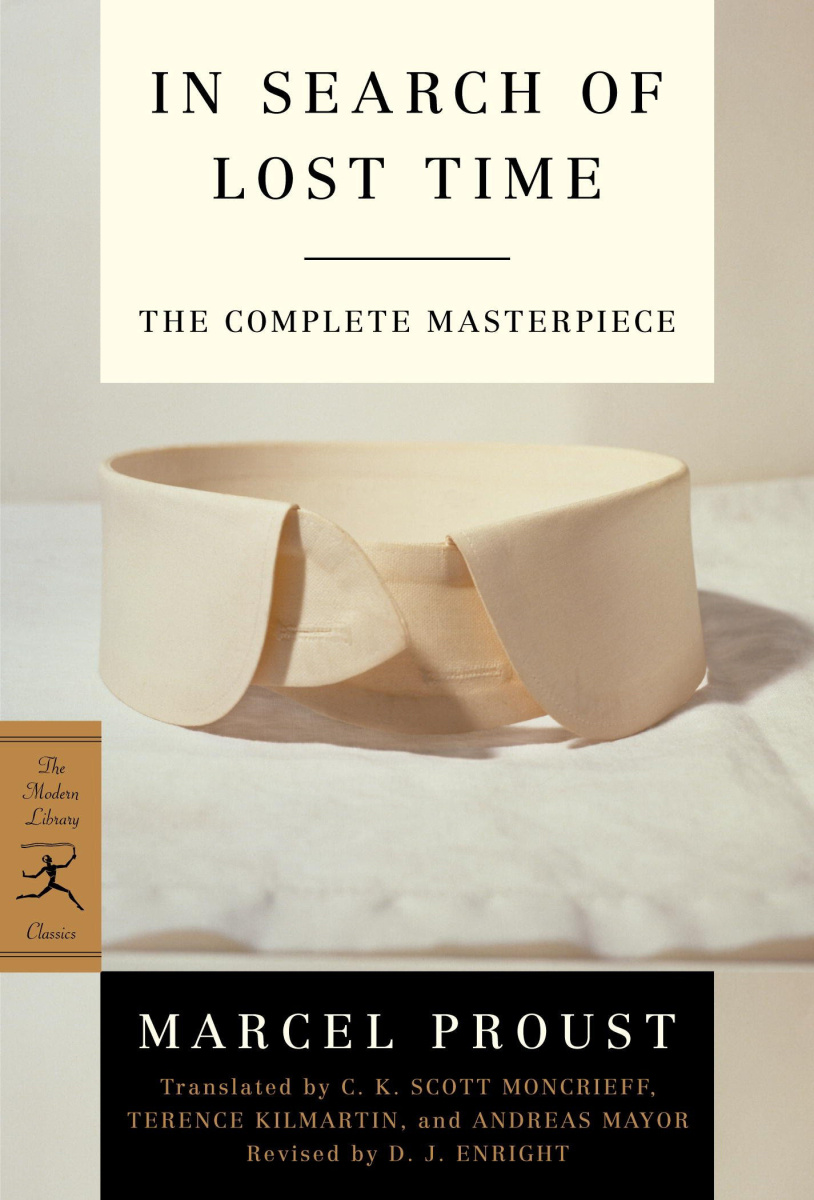
At the same time, 20th century social scientists also showed the contingent, shifting, and inconclusive nature of identity. Advancements like these laid the groundwork for ideas like the gender construct and identity fluidity, which are becoming more or less taken for granted. Today, it is naive to posit a “true self.” Developmental psychologist Robert Kegan has proposed “inter-individuality” as the final state of cognitive and interpersonal development, at which a person recognizes and can switch between their own self-systems. Kwinter would say it would be more accurate to liken the self to a fluid consciousness, in which cognition is not tied up in the self but concomitant to the world of things.
—
While these modernist movements challenged absolutism, note the difference between multiplicity and the postmodern lens. Kwinter includes a section called “Fragmentation vs Multiplicity.” Here he rehearses the distinction between thinking about phenomena and meaning “independent of an external, totalizing, foundational schema” as in the modernist advancements above, and the postmodern hypothesis that there is no intrinsic meaning to anything at all. As Kwinter notes, the this latter perspective is nihilistic, characterized by an anxiety of disenfranchisement and disorientation.
In practice, this is an extremely difficult tightrope to walk. It is so difficult in fact that writer and researcher David Chapman has written an entire book about it. In Meaningness he discusses how to hold a clearheaded “meta-systematic” perspective and avoid falling into absolutist or totally relativistic thinking.
Both Chapman and Kwinter know it is possible to maintain the recognition that meanings are like nodes at the intersection of various systems. Kwinter optimistically posits: “is it not possible, however, to restore to the fragment that which is properly its due, to develop it…as a specific characterization of matter within a continuous, fluctuating, and time-imbued multiplicity?”
Multiplicity is distinguished from postmodernism by its recognition of history and causality. Compare to Chapman:
“Eventually, one notices that meanings continue to operate quite well despite their lack of ultimate foundations. Systems re-emerge as transparent forms. You no longer see by means of systems, but can see through systems as contingent constructions that most people mis-take as solid…[systems and meanings] are both nebulous (intangible, interpenetrating, transient, amorphous, and ambiguous) and patterned (reliable, distinct, enduring clear, and definite).”
If there is an underlying rationality to the various connections that Kwinter makes in his book, it is the epistemic movement away from ultimate foundations which undergirded many early early 20th century advancements, and which is shared by post-modernism. Both these thinkers, however, emphasize the regularity and predictability of meanings.
By the later half of the century, many fields began to take multiplicity as a first principle for any sort of complex thinking or making. Actor-Network Theory, Object-Oriented Ontology, ethnomethodology, constructivist approaches in the social sciences, product semantics in design theory, and so on are all practical applications of a multifaceted take on meaning which do not dissolve into chaos.
Kwinter also shows the scientific underpinnings of multiplicity in space-time, and shows the historical thread of influence from Bergson to Einstein. This section requires a familiarity with thermodynamics and quantum physics that made it less legible to me, so I will not delve into it here. Kwinter also spends the second half of the book discussing how multiplicity defines the work of Franz Kafka. Most readings of Kafka describe his world as one of stasis where nothing ever happens. Kwinter’s is rather fresh in comparison—he shows the Kafkan universe to be one of intense flux and constant motion, shifting from one state to the next without clear beginning or end—but I don’t find Kafka scholarship particularly interesting so I won’t go further into this.
Messes of Concrete and Silicon
Qualitative multiplicity makes intuitive sense when dealing with the intangible. But it is also useful for thinking about physical, concrete things which compose our daily lived environment.
Kwinter points to Futurism as the first movement to recognize this. The Futurists are mostly remembered as basic techno-spiritualists yet their language clearly anticipates modern frameworks like those mentioned above. They used words like “plasticity” and “dynamism” to describe the material world of converging complexity they saw: “no one can any longer believe that an object finishes where another begins” (Boccioni quoted by Kwinter).
Futurist sculptor Boccioni called for “the interpenetration of planes” and the “absolute and complete abolition of finite lines.” The futurists also understood “the capacity of landscape and environment to act simultaneously on the human figure and on objects.” See for instance this drawing of a Station for Trains and Airplanes by Futurist architect Antonio Sant’Elia:
Kwinter is at his most lucid and inspired in this chapter on the futurists.
“It is difficult to say whether the station system is embedded in the city’s fabric or it is the city that runs freely through the station. The novelty of this arrangement has nothing to do with the ambiguity of place produced by such dispersion nor with any mere de-centering of once integral architectural forms, but with a more fundamental overhaul that permits one to conceive of the architectural object not as a form but as an agglomeration and interaction of functions each with its proper series of system elements whose architectonic value and role are defined only secondarily, and wholly in relation to those functions. Thus the Milan station becomes less a “building” than a field of convergence and linkup for many systems of flow, including air transport, trains, cars, radio signals, trams, funiculars, pedestrians, and all the secondary flows they host—money, goods information.” (Emphasis mine)
I was struck by how Kwinter’s description of Futurist thought is reminiscent of critical conversations about technology happening today. Writers on digital platforms describe algorithms as microsystems that “organize, structure, and channel information.” In art writing, it has become popular to explore the ways in which data can be said to have agency. Data is not just a pool of information sitting on a server somewhere; it is said to be economically productive, and it plays a role in making real-time interface changes, affecting user behavior. The notion of multiplicity makes it easy to remember the web is not a series of individual “documents” but the convergence of various networks and systems of information and capital in flow.
In particular I was reminded of Benjamin Bratton’s book The Stack. The Stack is an attempt to think about geopolitics in the terms of a “technical stack.” A company’s tech stack is composed of network and infrastructural elements, including DNS systems and ultimately servers in a rack frequently owned by Amazon or Microsoft; a database; business logic in code like Python or Java, and the interface part of the model-view-controller which provides users ways to interact with this system.
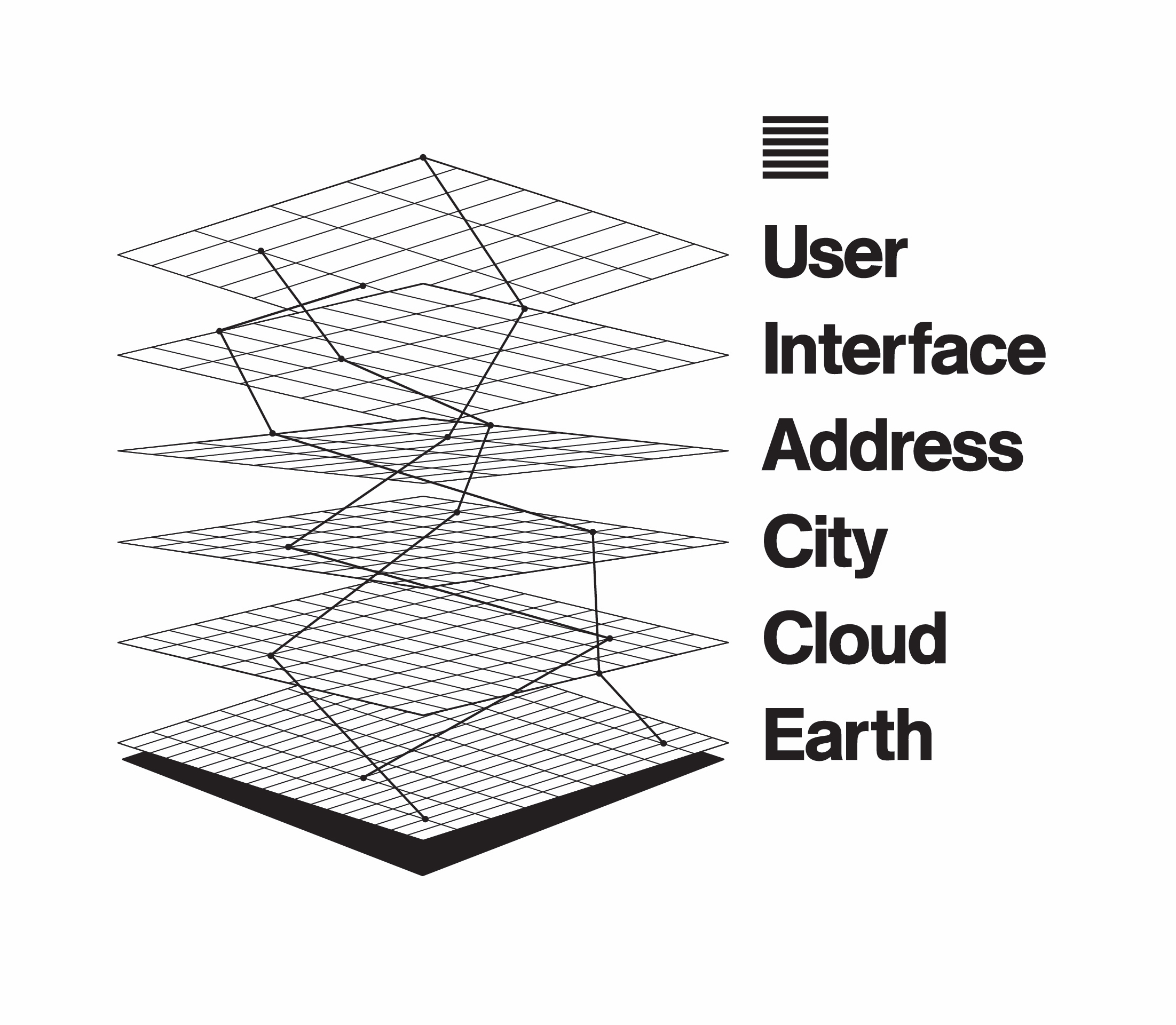
Bratton extrapolates this architecture to speak of the entire world as an “accidental megastructure” with several layers. He uses language like “conflict, interpenetrate, relate, combine, blur” and so forth to describe how the layers of this Stack and their functions are impossible to extract from one another.
The Stack is a qualitative multiplicity, both immaterial and concrete. Its composition includes the silicon that stores our fingerprint data and the hydroelectric dams that power server farms; it includes the status of “citizenship” conferred by companies like Google and Facebook which provide public services traditionally offered by the state. As foreseen by the Futurists, the Stack is not about “objects and elements” but the “mobilization and productive possibilities of abstract functions.”
—
I recently picked up Tsutomu Nihei’s masterpiece manga Blame! At Kinokuniya NYC, inspired to reread it by the terrible made-for-Netflix OVA. In Blame! the Stack reaches its logical conclusion. Automated builders construct a networked megacity that has no beginning nor end. The city is the agent of its own construction, but its multiple classes of artificially intelligent life forms—which often appear to be inseparable from the city itself—often have conflicting or orthogonal goals.
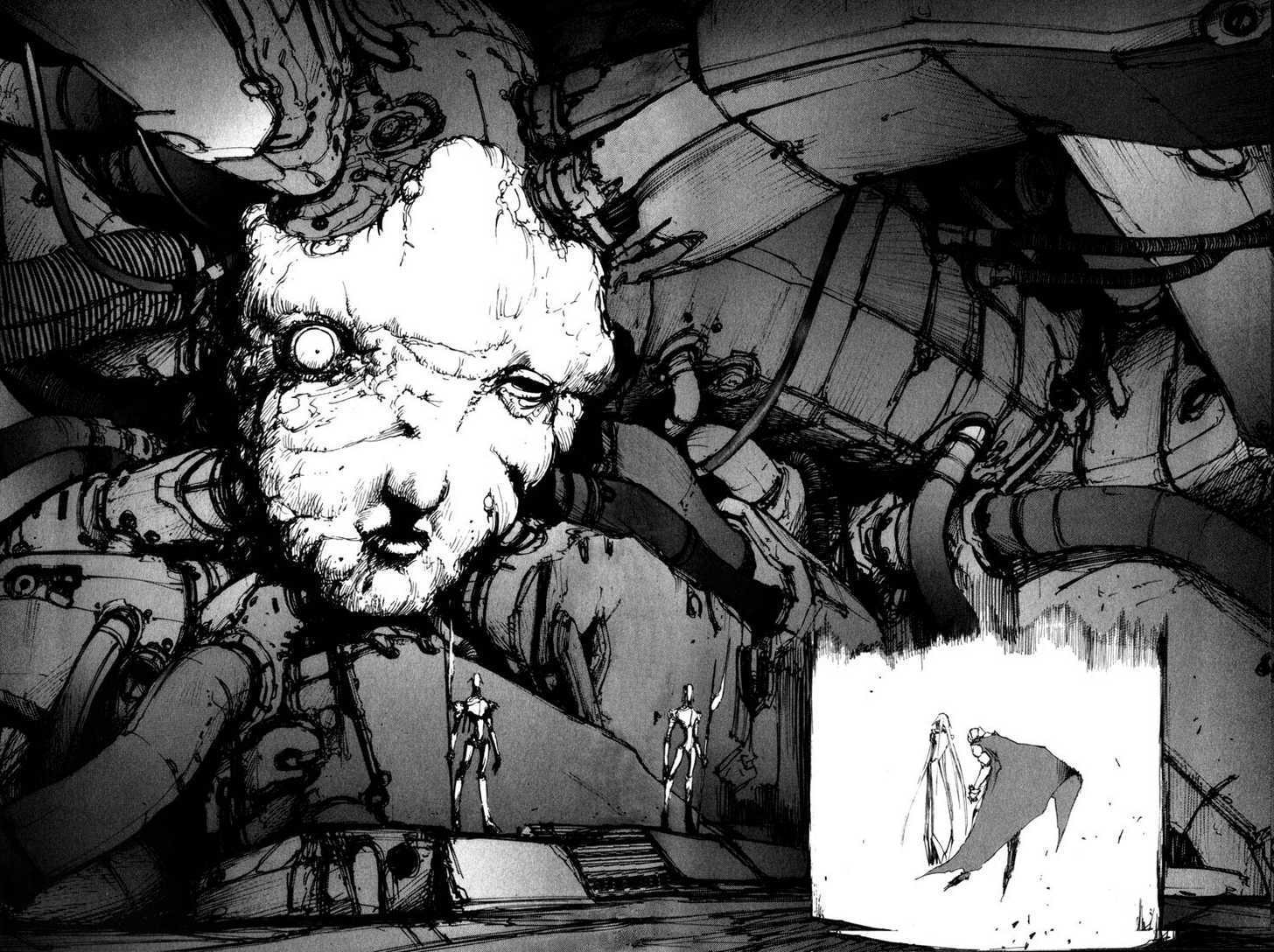
The conflicts of these components are also visible in the physical makeup of the city, which has grown around and into ancient human domiciles. Stone stairways frequently lead to solid metal walls; on the other hand, entering a door that appears to go “inward” may merely lead to a vast open space. There is no “outside” so nothing can properly be said to be interior or exterior to anything else.
No object is isolated. Everything is connected by pipes, wires, passages, and communication wires. As a silicon entity fused with an elevator says:
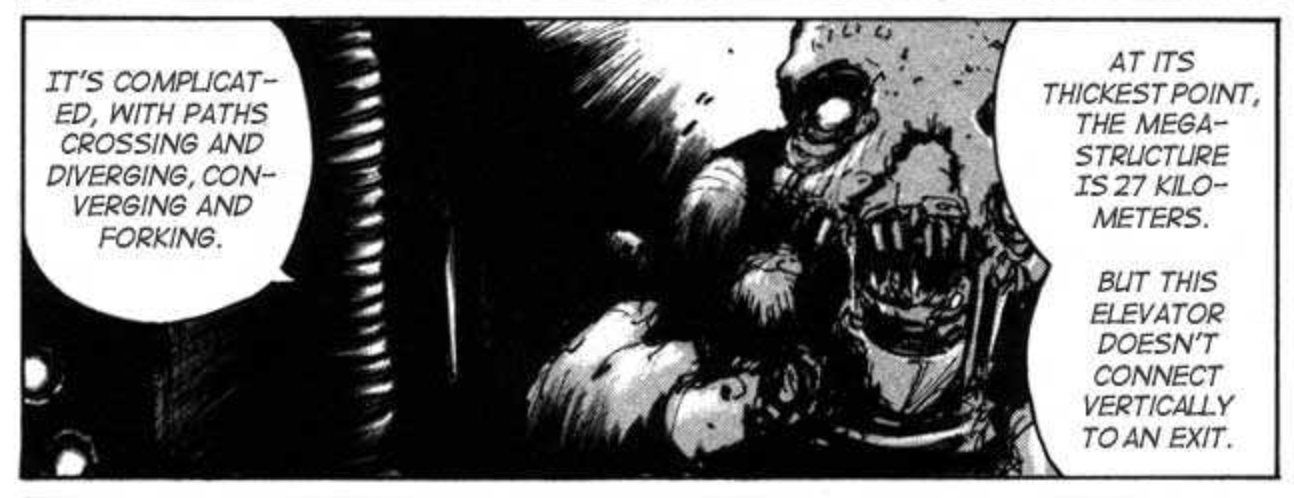
The protagonists in Blame! have two ways of navigating this infinite interior. One way is the Graviton Beam Emitter, the only weapon that can blast holes in the megastructure. Like Bruce Willis in Nakatomi Space, Killy often moves by busting through impenetrable spaces.

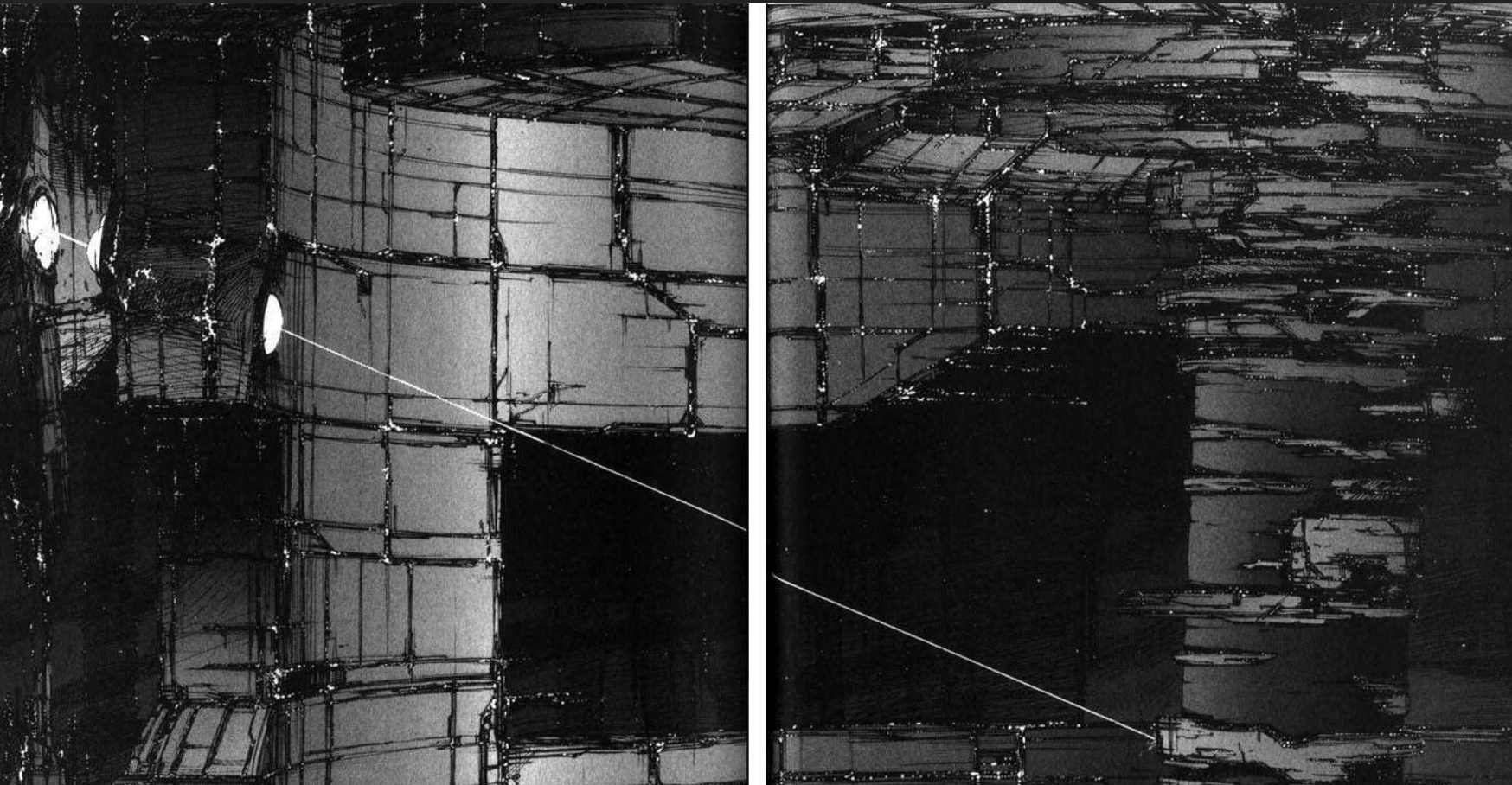
Characters Killy meets remark over and over again that traversing the thick ceilings of the city strata would be impossible without the GBE. Access to the gun or lack thereof is a plot device that creates forward movement through the narrative. In dealing with our personal or social systems, what tools do we have to incise, hack, or blast through layer upon layer?

The other method of navigation is the alteration of the system by which characters operate. The networked nature of the entire city means that personality and memory are transferable. Killy’s companion Cibo (pictured above) dies several times and repeatedly finds herself in new bodies. Coopted from other species of silicon-based life, these new bodies give her new abilities: to open different types of doors, interact with the Builders, to sense the city, and more. This mutability of form is not an infiltration or penetration but a literal “code switch,” a way of altering oneself to navigate the different systems one encounters.

Towards Understanding Multiplicity
At the beginning of these notes I suggested that “aesthetic logic” can be valuable. This last section about Blame! could be considered a simple example of how this suggestive mode of writing works in practice.
I likened this type of writing to art writing. Artists, one remembers, supposedly anticipate and depict changes in the world sooner than other members of society. Viewed from this lens, philosophy is a kind of art. Philosophers too use abstractions and obtuse language, aesthetic logic, to get at Big Questions or anticipate the future. To the degree that philosophy and art discourse draw on each other, they are both part of this projective and aesthetic act of “making strange.”
Things philosophers say (and things artists make) often look prosaic, or obvious in retrospect. We jest about this: Alan Watts calls the philosopher an “intellectual yokel who gawks at things regular people take for granted.” But I think this is because the things artists and philosophers anticipate and “make strange” eventually become a regular part of our lives.
In the last century, artists and writers aesthetically anticipated a new epistemology based on multiplicity, and theorists proved out its existence, often with aesthetic logic. The work of the deconstructionists, for instance, is regarded as important but among the most difficult to understand. Kwinter’s work suffers from the same characteristics. Today we need a simpler language to characterize multiplicity. We are reaching a time when the construction of meaning is taken for granted. We are leaving behind the modern project and entering a completely new mode of thought.
A friend has been bugging me for a year to find a better way to explain what David Chapman calls “meta-systematicity.” Reading Kwinter helped me understand better the 20th century developments that ground Chapman’s work, but presenting “meta-systematicity” as “multiplicity” would be a step backwards. Chapman’s explanations are already much more accessible than other accounts of the same story. We may not yet have a popular language that helps us think about the systems of the world, but we’re getting there.
